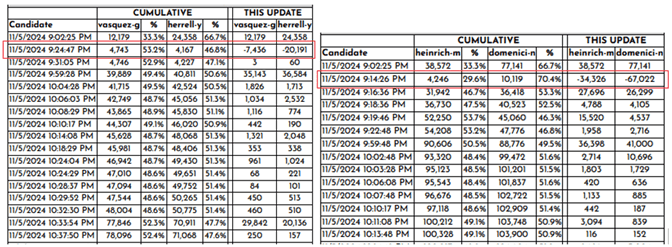Several candidates throughout the state are reporting that the polling data they collected when walking door-to-door does not match the outcome reported by the Secretary of State, leaving them questioning the legitimacy of yet another election. Sadly, New Mexico’s elections are far from secure and can be easily manipulated by the holes in the system even without the knowledge of the County Clerks.
A full audit and door-to-door canvass of an election is really the only way to determine if the election was honest or not, but the study of the Election Night Reporting (ENR) data can provide an early indicator of whether the election was honestly counted and reported
Unfortunately, the election night reporting for races in New Mexico shows anomalous behavior in most of the top of the ticket races that indicates manipulation was occurring. The source of the data is the Edison/New York Times data stream, which is obtained from Scytl – a foreign-owned company which has a monopoly on collection and dissemination of ENR data in the United States. It is understood that ENR data is “unofficial” and “preliminary,” but the Federal Election Assistance Commission (EAC) mandates that it must be accurate – leaving election administrators with no excuse for reporting false data or using calculated models to create reports.
The Edison/New York Times data is what all national media outlets use to report the status of the races of national importance, and ultimately call the winners. Candidates claim victory and concede their races based on this data. It is often the only data the public ever sees. Sadly, it has been shown to be widely manipulated or even fabricated, and New Mexico’s 2024 election was no different. This manipulation is easy to see by studying a handful of graphed results and comparing the races to each other.
For example, look at the red circle on the graph for Congressional District 2 (Figure 1), U.S. Senate (Figure 2), and Constitutional Amendment 1 (Figure 3) below:



The red circles highlight impossible behavior in the initial reporting of votes for these races. A few minutes after the close of the polls, the reporting showed a substantial lead for the Republican candidates, Yvette Herrell and Nela Domenici, and the “Against” option on the Constitutional Amendment. About half an hour later, almost all these “votes” were removed in these three races, greatly minimizing the Republican and “Against” lead, which were later overcome as the reporting went on.
Here is the raw data for the Congressional and Senate races showing votes being removed – affecting the Republican candidates more than the Democrats:

There is only one legitimate reason for reported results to be removed in the ENR data, and that is if a County Clerk somehow realizes they made a mistake uploading their data, recalls it in the software, and then uploads a corrected set of data later. If that was the case, there would be corresponding injections and removals in all the races voted on in that county because results are digitally reported at the same time. Now look at the Presidential graph in Figure 4 below. There is no similar injection and removal of votes in that race, meaning a County Clerk recalling results is not the explanation for the removal of votes in Figures 1-3.

Also, if the ENR data was honest, all statewide races should show similar numbers of votes having been cast at all times throughout the evening, but they don’t. For example, there is a large injection of votes at the 7:31 pm mark in the Congressional District 2 race after which about 80,000 total votes are reported (see the blue circle on Figure 1). All statewide races should show about 80,000 votes cast at that time. But Amendment 1 (see the blue circle on Figure 3) still shows zero votes cast at that time!
Another anomaly can be seen in the Congressional District 3 race (see the purple circle on Figure 5). There is a large injection of votes for the Democrat candidate at about 8:17 pm, but the corresponding injection for the Republican candidate doesn’t show up until several timestamps later at around 8:29 pm. There is no honest explanation for that based on the reporting processes of the County Clerks:

There is also an anomaly in the reporting for the third-party candidates for the Presidential race. The first report gave the third-party candidates several hundred votes each, which were removed in the next report. There are other removals later in the record for the third-party candidates as well:

An excuse often offered for anomalies like these is a “glitch” in the software. This is an unacceptable explanation because software follows its programming – it doesn’t have random “glitches.” There is always a cause, it doesn’t act on its own. The SOS tests the election night reporting system before the election to ensure that everything is working properly. If it was a “glitch,” why didn’t it show up in their pre-election testing?
Lastly, the SOS has offered the excuse that the Edison/New York Times data is third party and not their responsibility. This is also unacceptable as previously stated – the nation relies on these numbers and federal law requires it to be accurate. The SOS has the responsibility to know how New Mexico’s data is being reported to the nation and if there is a problem, she has a responsibility to fix it.
Citizens should never accept “software glitch” as an explanation from their election officials as to why impossible things are happening in their election data. Neither should any candidate accept getting “glitched” into office or concede when “glitches” are present. We must demand genuine, technically sound, vetted explanations for the anomalies in the data, or accept the fact that the election system is, in fact, being subverted.
- Opinion | New Mexico will Get Voter ID and Our Corrupt SOS and Captured Legislature Won’t Be Able to Stop It - January 30, 2025
- Election Night Reporting Shows Manipulation Occurred in New Mexico’s 2024 Election - November 12, 2024
- Dona Ana County Holds Another Round of Third-World Elections - November 12, 2024


